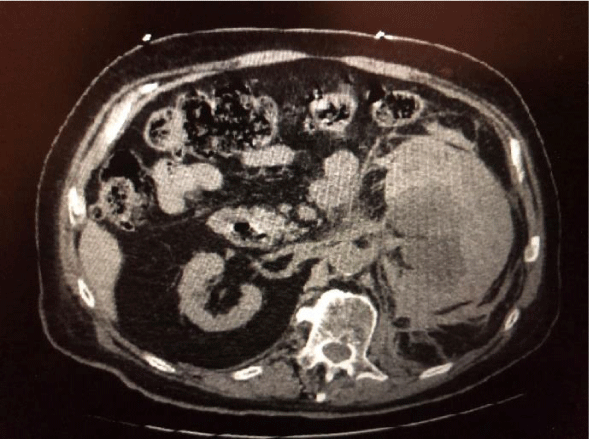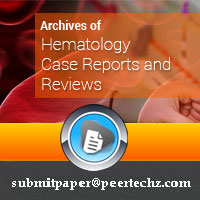Archives of Hematology Case Reports and Reviews
Spontaneous Subcapsular Hematoma from Rivaroxaban
Swetha Chenna1, Amy R Hurst2, Jason B Douglas2, Venu Madhav Chippa2*, Matthew R Fulton3 and Amr Moussa4
2Department of Hospital medicine, Mercy Health West Hospital, Cincinnati, Ohio, USA
3Department of Urology, Mercy Health West Hospital, Cincinnati, Ohio, USA
4Department of Nephrology, Mercy Health West Hospital, Cincinnati, Ohio, USA
Cite this as
Chenna S, Hurst AR, Douglas JB, Chippa VM, Fulton MR, et al. (2018) Spontaneous Subcapsular Hematoma from Rivaroxaban. Arch Hematol Case Rep Rev 3(1): 004-006. DOI: 10.17352/ahcrr.000012Rivaroxaban was approved for stroke prevention for non-valvular atrial fibrillation in 2011, with added advantage of decreased risk of bleeding in comparison to coumadin, made it a good alternative for coumadin. We report a case of severe subcapsular and intrarenal hematoma associated with Rivaroxaban in an elderly male with chronic kidney disease. He presented with severe left sided flank pain, shock and acute on chronic renal failure, he was successfully resuscitated with supportive care. We aim to alert primary care physicians, hospitalists, Emergency room physicians and cardiologists regarding the likelihood of encountering similar cases as the indications of direct acting oral anticoagulants are increasing and gaining more popularity in physicians and patients as well.
Introduction
Rivaroxaban is indicated for stroke prevention in non-valvular atrial fibrillation, treatment of acute deep vein thrombosis and pulmonary embolism, deep vein thrombosis prophylaxis after hip and knee replacement surgeries and reduction in the risk of recurrence of deep venous thromboembolism and pulmonary embolism. Once daily using, predictable pharmacokinetics and multiple dose options for patients with chronic kidney disease makes it a very good coumadin alternative. [2]. Though the bleeding risk is less than coumadin in comparison, the risk remains. The common causes of Spontaneous renal hematomas are renal cysts, vascular lesions and renal tumors [1]. The clinical presentation is very different, based on acuity and duration of onset. We present a spontaneous subcapsular and intrarenal hematoma in a patient who is on chronic anticoagulation with Rivaroxaban.
Case Presentation
A 74-year-old male presents to emergency room with severe left flank pain, blood in urine and blood pressure of 77/55 millimeters of Mercury. He was resuscitated with fluids and his blood pressure improved to 105/70 millimeters of Mercury. His past medical history includes old cerebrovascular accident with residual left hemiparesis, chronic atrial fibrillation for which he is on anticoagulation with Rivaroxaban 20 milligrams daily, chronic kidney disease stage 3 from prolonged hypertension, diabetes mellitus type 2, and coronary artery disease with chronic congestive heart failure with reduced ejection fraction. He was sent to CT scan of the abdomen without contrast to rule out a kidney stone, but to our surprise we found large left subcapsular and intrarenal hematoma with hydronephrosis and hydroureter (Figure 1). He had urinary retention in Emergency room and he required straight catheterization, with return of 200 ml fresh blood.
He was admitted to ICU. His hemoglobin at admission was 9.9 g/dl, which was 13.1 g/dl a month prior, given such an acute drop, he received 1unit of blood in Emergency room itself. He had persistent flank pain with blood in Foley bag and repeat hemoglobin showed further drop in hemoglobin, he received 4 more units of blood. We were unable to give him Andexanet alfa because it was not available in our pharmacy and prothrombin complex concentrate was back order in our pharmacy, so he received Factor IX transfusion. We have consulted Urology from emergency room and planned supportive care for management. On day 2 of hospital stay his creatinine worsened from 3.8 mg/dl to 4.6 mg/dl and then to 5.2 mg/dl the next day, nephrology was consulted for his worsening kidney function. He went for embolization of renal artery given on going bleed, but unfortunately no active bleeding vessel was identified. On day 3 of hospital his hemoglobin and creatine were stabilized, and his urine output improved from day 4.
Given his history of stroke with hemiparesis and persistent atrial fibrillation with life threatening nature of bleed, he was seen by cardiology for Left atrial appendage closure (watchman procedure) [4], he was later discharged to Acute rehabilitation for further recovery.
Discussion
Renal hematomas can be classified as traumatic and spontaneous, though both present differently, treatment approach is similar [5]. The subcapsular hematoma is commonly associated with various pathological conditions such as neoplasm and vascular disease. Renal neoplasms are the most common cause of Subcapsular hematoma. Angiomyolipoma is the most common benign neoplasm responsible for Subcapsular hematoma, while renal cell carcinoma is the most common malignant neoplasm [6]. In modern clinical practice we commonly see renal hematomas following kidney biopsies in patients who were on anticoagulation. Spontaneous subcapsular hematomas may be present with “Lenk’s triad” which consists of lumboabdominal pain, palpable mass, and a general deterioration with hypovolemic shock [5].
There are two schools of thought regarding management of such cases. Kendall et al., proposed radical nephrectomy as a treatment of such conditions where there is no apparent etiology and normal contralateral kidney with careful pathological examination because of high incidence of small renal tumors [8].
In contrast, Morgentaler et al. proposed nephrectomy only in patients with nonfatty lesions other than hematoma. All other patients were followed by serial CT scan [9], Bosniak et al. even claimed that operative exploration is not necessary in most unexplained cases because of the diagnostic accuracy of CT scan using 5 mm sections and contrast medium [10]. If etiology cannot be determined at the primary examination, follow-up CT should be performed at 3-month intervals until the hematoma resolves and a definite diagnosis is possible. Conservative management is also supported by Brkovic et al., Koo et al., Srinivasan et al., and Powel et al. [11-13].
In 2006 Ferrando et al. reported the first spontaneous subcapsular hematoma in an anticoagulated patient with acenocoumarol (coumadin) but our case appears to be the first case with Rivaroxaban [7].
In the EINSTEIN DVT, PE, and Extension clinical studies, both thrombotic and bleeding event rates were higher in patients over the age of 65 than in those under the age of 65 [14]. Furthermore, Rivaroxaban is not favored in patient with decreased creatinine clearance as drug exposure is increased, and the risk of bleeding is elevated. Our patient was 74 years old with mild to moderate renal dysfunction. The recommended dose of Rivaroxaban per package insert is 20 mg once daily for CrCl >50 mL/min, and 15 mg once daily for patient with CrCl 15 to 50 mL/min (Table 1). The patient’s CrCl was 37 mL/min. Therefore, his recommended daily dose was 15 mg once daily, but he was on 20 mg daily prior to admission
Possible suboptimal anticoagulation due to the predominance of thromboembolic event, in additional to the risk of bleeding, should be balanced against the favorable characteristics of rivaroxaban in patients who opted for newer anticoagulants. Prescribing physicians should be aware of dose adjustments of Rivaroxaban based on renal function, a thorough discussion with patient about the advantages and disadvantages is very much important to help patient understand about their medications. With the new oral anticoagulants rise in popularity Hospitalist and Emergency Physicians should be aware of reversal agents in case of life-threatening bleed (Table 2). Accessibility of reversal agents is equally important to prevent further bleed and stabilizing the patient.
Conclusion
Now a days new oral Anticoagulation drugs are more commonly used than before, given many advantages, however adverse effects does occur. This is the first case report documenting spontaneous intrarenal and subcapsular hematoma associated with Rivaroxaban. Prescribing physicians should be cautious in prescribing Rivaroxaban to elderly patients with hepatic or renal dysfunction. Management of anticoagulation in Chronic Kidney Disease requires special emphasis to minimize complications from bleeding from over-anticoagulation while dosing adequately. Close liaison with the Hematologists, Nephrologist and Cardiologist may be beneficial in this regard and setting up local hospital protocols is of a great value [3].
- Greco M, Butticè S, Benedetto F, Spinelli F, Traxer O, et al. (2016) Spontaneous Subcapsular Renal Hematoma: Strange Case in an Anticoagulated Patient with HWMH after Aortic and Iliac Endovascular Stenting Procedure. Case Rep Urol 2016: 2573476. Link: https://goo.gl/gUeJKx
- Lo JC, Gerona RR (2014) A Case of Rivaroxaban Associated Intracranial Hemorrhage. West J Emerg Med 15: 375-377. Link: https://goo.gl/UeMEcv
- Hughes S, Szeki I, Nash MJ, Thachil J (2014) Anticoagulation in chronic kidney disease patients—the practical aspects. Clin Kidney J 7: 442-449. Link: https://goo.gl/vNqZb9
- Boersma LV, Ince H, Kische S, Pokushalov E, Schmitz T, et al. (2017) Efficacy and safety of left atrial appendage closure with WATCHMAN in patients with or without contraindication to oral anticoagulation: 1-Year follow-up outcome data of the EWOLUTION trial. Heart Rhythm 14: 1302-1308. Link: https://goo.gl/bxuu7U
- Armenakas NA, Renal Trauma. Link: https://goo.gl/bY8Dyo
- Katabathina VS, Katre R, Prasad SR, Surabhi VR, Shanbhogue AK, et al. (2011) Wunderlich syndrome: cross-sectional imaging review. J Comput Assist Tomogr 35: 425-433. Link: https://goo.gl/djxmL3
- Ferrando F, Budía A, Mira Y, Vayá A, Aznar J (2006) Spontaneous renal subcapsular hematoma in an anticoagulated patient. Clin Appl Thromb Hemost 12: 89-92. Link: https://goo.gl/d6FyZk
- Kendall AR, Senay BA, Coll ME (1988) Spontaneous subcapsular renal hematoma: Diagnosis and management. J Urol 139: 246-250. Link: https://goo.gl/Poaspt
- Morgentaler A, Belville JS, Tumeh SS, Richie JP, Loughlin KR (1990) Rational approach to evaluation and management of spontaneous perirenal hemorrhage. Surg Gynecol Obstet 170: 121-125. Link: https://goo.gl/GTQxoA
- Bosniak MA (1989) Spontaneous subcapsular and perirenal hematomas. Radiology 172: 601-602. Link: https://goo.gl/vT3Cgn
- Brkovic D, Moehring K, Doersam J, Pomer S, Kaelble T, et al. (1996) Diagnosis and management of spontaneous perirenal haematomas. Eur Urol 29: 302–307. Link: https://goo.gl/1ugcDX
- Srinivasan V, Turner AG, Blackford HN (1994) Massive intraperitoneal hemorrhage associated with renal pathology. J Urol 151: 980-981. Link: https://goo.gl/yrQ15H
- Koo V, Duggan B, Lennon G (2004) Spontaneous rupture of kidney with peri-renal haematoma: A conservative approach. Ulster Med J 73: 53-56. Link: https://goo.gl/wcP7xY
- EINSTEIN Investigators. Bauersachs R, Berkowitz SD, Brenner B, Buller HR, et al. (2010) Oral rivaroxaban for symptomatic venous thromboembolism. N Engl J Med 363: 2499-2510. Link: https://goo.gl/63Xffp
Article Alerts
Subscribe to our articles alerts and stay tuned.
 This work is licensed under a Creative Commons Attribution 4.0 International License.
This work is licensed under a Creative Commons Attribution 4.0 International License.


 Save to Mendeley
Save to Mendeley
